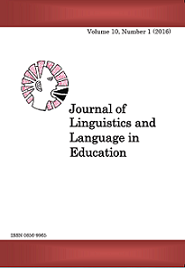A Socio-academic Reflection of College student's slang Expressions
Abstract
This paper sought to contribute knowledge to the field of sociolinguistics
(register). It specifically identified and categorised slang expressions used by
the Dar es Salaam University College of Education (DUCE) students studying
Bachelor Degree of Arts with Education (BAED) and Bachelor Degree of
Education (BED) in day􀂲to􀂲day socio-academic interactions. Data were
collected through questionnaire from forty (40) students. The slang expressions
were categorised in respect to the meanings/interpretations expressed by the
respondents. The categories include slang expressions associated with
academics, food and drinks, money, body shapes/parts, people and studying
areas. It is concluded that the application of slang expressions motivates DUCE
ô€–ô€—ô€˜ô€‡ô€ˆô€‘ô€—ô€–ô€‚·ô€€ƒ ô€–ô€’ô€†ô€Œô€’-academic interactions as well as strengthening their
relationships and bring forth a sense of belongingness.
Key words: College students, socio-academic interactions, slang expressions
References
References
ô€€¤ô€‡ô€•ô€Œô€„ô€‘ô€—ô€’ô€€ô€€ƒô€€¤ô€€‘ô€€ƒô€€¶ô€€‘ô€€ƒô€€‹ô€€•ô€€“ô€€”ô€' ô€€Œô€€‘ô€€ƒô€€¶ô€—ô€˜ô€‡ô€œô€€ƒô€’ô€‰ô€€ƒô€€¶ô€ô€„ô€‘ô€Šô€€ƒô€€ºô€’ô€•ô€‡ô€€ƒô€Œô€‘ô€€ƒô€‚´ô€€µô€Œô€‡ô€ˆô€€ƒô€€¤ô€ô€’ô€‘ô€Šô€‚µô€€ƒô€€°ô€’ô€™ô€Œô€ˆô€€‘ô€€ƒ
Unpublished ô€€°ô€„ô€–ô€—ô€ˆô€•ô€‚·ô€–ô€€ƒ ô€€§ô€Œô€–ô€–ô€ˆô€•ô€—ô€„ô€—ô€Œô€’ô€‘ô€€ô€€ƒ ô€—ô€‹ô€ˆô€€ƒ ô€€¶ô€—ô€„ô€—ô€ˆô€€ƒ ô€€¬ô€–ô€ô€„ô€ô€Œô€†ô€€ƒ
University Maulana Malik Ibrahim Malang.
Agha, A. (1999). Register. Journal of Linguistic Anthropology, 9(2).
􀂲219.
Ainiala, T. (2012). Place Names and Identities: The Uses of Names of
Helsinki. In B. Helleland, C. E. Ore & S. Wikstrøm (eds.).
Names and Identities: Oslo Studies in Language 4(2): 7􀂲15.
Agha, A. (2015). Tropes of Slang. Signs and Society, 3(2): 306􀂲330.
Al-Kharabasheh, A. & Yassin, O. (2017). Translation of
Colloquialisms in the Arabic-into-English Subtitled Film, The
Dupes. International Journal of Comparative Literature &
Translation Studies, 5(3): 18􀂲27.
Arua, E. & Alimi, M. M. (2009). The Creation of Students' Academic
Slang Expressions in the University of Botswana. Linguistic
Online, 40(4): 15􀂲28.
Dozie, C. P. & Madu, L. I. (2012). Language of Communication
among University Students in Nigeria: A Study on Slangy
Expressions in Federal University of Technology Owerri,
Nigeria. Journal of Communication, 3(2): 99􀂲103.
Eble, C. (2009). Slang and the Internet. New Challenges in Language
and Literature. FALE/UFMG: 81􀂲95.
El Falaky, M. S. (2016). Yes We Are: A Sociolinguistic Study of
Egyptian Slang. International Journal of Language and
Literature, 4(2): 75􀂲84.
Fisher, D. & Lapp, D. (2013). Learning to Talk like the Test: Guiding
Speakers of African American Vernacular English. Journal of
Adolescent & Adult Literacy, 56(8): 634􀂲648.
ô€€©ô€’ô€•ô€–ô€–ô€Žô€®ô€‹ô€ô€€ô€€ƒ ô€€°ô€€‘ô€€ƒ ô€€‹ô€€•ô€€“ô€€“ô€€”ô€€Œô€€‘ô€€ƒ ô€€ªô€Œô€•ô€ô€–ô€‚·ô€€ƒ ô€€¶ô€ô€„ô€‘ô€Šô€€ƒ ô€„ô€‘ô€‡ô€€ƒ ô€€¥ô€’ô€œô€–ô€‚· Slang: Two Towns in
Finland Visited. Nora: Nordic Journal of Women's Studies,
(2): 98􀂲106.
Giles, H. & Ogay, T. (2007). Communication Accommodation Theory.
In B. B. Whaley & W. Samter (eds.). Explaining
communication: Contemporary Theories and Exemplars.
Mahwah, NJ, US: Lawrence Erlbaum Associates Publishers:
􀂲310.
Gomaa, Y. A. (2015). Saudi Youth Slang Innovations: A
Sociolinguistic Approach. International Journal of Linguistics
and Communication, 3(2): 98􀂲112.
Kariuki, A. Kanana, F. E. & Kebeya, H. (2015). The Growth and Use
of Sheng in Advertisements in Selected Businesses in Kenya.
Journal of African Cultural Studies, 27(2): 229􀂲246.
| A Socio-ô€„ô€†ô€„ô€‡ô€ˆô€ô€Œô€†ô€€ƒô€€µô€ˆô€‰ô€ô€ˆô€†ô€—ô€Œô€’ô€‘ô€€ƒô€’ô€‰ô€€ƒô€€¦ô€’ô€ô€ô€ˆô€Šô€ˆô€€ƒô€€¶ô€—ô€˜ô€‡ô€ˆô€‘ô€—ô€–ô€‚·ô€€ƒô€€¶ô€ô€„ô€‘ô€Šô€€ƒô€€¨ô€›ô€“ô€•ô€ˆô€–ô€–ô€Œô€’ô€‘ô€–
Kothari, C. R. (2004). Research Methodologies: Methods and
Techniques. New Delhi: New International Age (P) Ltd.
Lewadowski, M. (2010). Sociolects and Registers: A Contrastive
Analysis of two Kinds of Linguistic Variation. Linguistics
Research, 20: 60􀂲79.
Liaw, J. O. Dani, N. A. & Johari, A. Z. (2013). Language Usage of
Jargon and Slang in Strategic Studies. Australian Journal of
Basic and Applied Sciences, 7(4): 661􀂲666.
Mazer, J. P. & Hunt, S. K. (2008). The Effects of Instructor Use of
Positive and Negative Slang on Student Motivation, Affective
Learning, and Classroom Climate. Communication Research
Reports, 25(1): 44􀂲55.
Mutonya, M. (2008). Swahili Advertising in Nairobi: Innovation and
Language Shift. Journal of African Cultural Studies, 20(1): 3􀂲
Pedersen, T. (2009). The Use of Slang in British English?: A Study of
the Slang Used in Football Factory and Little Britain.
ô€€¸ô€‘ô€“ô€˜ô€…ô€ô€Œô€–ô€‹ô€ˆô€‡ô€€ƒô€€°ô€„ô€–ô€—ô€ˆô€•ô€‚·ô€–ô€€ƒô€€§ô€Œô€–ô€–ô€ˆô€•ô€—ô€„ô€—ô€Œô€’ô€‘ô€€ The University of Kalmar.
Saal, E. O. (2010). The Persuasive Effect of Teenager Slang in Printbased
HIV Messages. Unpublished PhD Dissertation,
Radboud University.
Wijaya, B. S. (2013). The Use of English Slang Words in Informal
Communication among 8th Semester Students of English
Department in Binus University. Humaniora, 5(1): 197􀂲209.
Yaghan, M. A. (2008). ô€‚´ô€€¤ô€•ô€„ô€…ô€Œô€ô€Œô€‚µ: A Contemporary Style of Arabic
Slang. Design Issues, 24(2): 39􀂲52.
Yule, G. (2010). The Study of Language (3rd Edition). Cambridge:
Cambridge University Press.
Zhou, Y. & Fan, Y. (2013). A Sociolinguistic Study of American
Slang. Theory and Practice in Language Studies, 3(12): 2209􀂲
Downloads
Published
Issue
Section
License
Copyright © by Department of Foreign Languages and Linguistics, University of Dar es Salaam
All rights reserved. No part of this publication may be reproduced or transmitted in any form or by any means, electronic or mechanical, including photocopying, recording, or any information storage or retrieval system, without permission in writing from the publisher, except for short extracts in fair dealing, for research or private study, critical scholarly review or discourse with an acknowledgement.



